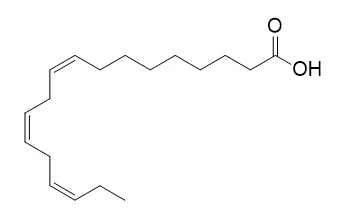| In vivo: |
| J. Nutr.,2004 Nov;134(11):2991-7. | | Dietary alpha-linolenic acid reduces inflammatory and lipid cardiovascular risk factors in hypercholesterolemic men and women.[Pubmed: 15514264] |
METHODS AND RESULTS:
Alpha-Linolenic acid (ALA) reduces cardiovascular disease (CVD) risk, possibly by favorably changing vascular inflammation and endothelial dysfunction. Inflammatory markers and lipids and lipoproteins were assessed in hypercholesterolemic subjects (n = 23) fed 2 diets low in saturated fat and cholesterol, and high in PUFA varying in ALA (ALA Diet) and linoleic acid (LA Diet) compared with an average American diet (AAD). The ALA Diet provided 17% energy from PUFA (10.5% LA; 6.5% ALA); the LA Diet provided 16.4% energy from PUFA (12.6% LA; 3.6% ALA); and the AAD provided 8.7% energy from PUFA (7.7% LA; 0.8% ALA). The ALA Diet decreased C-reactive protein (CRP, P < 0.01), whereas the LA Diet tended to decrease CRP (P = 0.08). Although the 2 high-PUFA diets similarly decreased intercellular cell adhesion molecule-1 vs. AAD (-19.1% by the ALA Diet, P < 0.01; -11.0% by the LA Diet, P < 0.01), the ALA Diet decreased vascular cell adhesion molecule-1 (VCAM-1, -15.6% vs. -3.1%, P < 0.01) and E-selectin (-14.6% vs. -8.1%, P < 0.01) more than the LA Diet. Changes in CRP and VCAM-1 were inversely associated with changes in serum eicosapentaenoic acid (EPA) (r = -0.496, P = 0.016; r = -0.418, P = 0.047), or EPA plus docosapentaenoic acid (r = -0.409, P = 0.053; r = -0.357, P = 0.091) after subjects consumed the ALA Diet. The 2 high-PUFA diets decreased serum total cholesterol, LDL cholesterol and triglycerides similarly (P < 0.05); the ALA Diet decreased HDL cholesterol and apolipoprotein AI compared with the AAD (P < 0.05).
CONCLUSIONS:
ALA appears to decrease CVD risk by inhibiting vascular inflammation and endothelial activation beyond its lipid-lowering effects. | | Cancer ence, 2010, 93(2):133-142. | | Dietary conjugated linolenic acid inhibits azoxymethane-induced colonic aberrant crypt foci in rats.[Pubmed: 11856476] |
METHODS AND RESULTS:
The modifying effects of dietary feeding of conjugated Linolenic acid (CLN) isolated from the seeds of bitter gourd (Momordica charantia) on the development of azoxymethane (AOM)-induced colonic aberrant crypt foci (ACF) were investigated in male F344 rats to predict its possible cancer chemopreventive efficacy. The effect of CLN on the proliferating cell nuclear antigen (PCNA) index in colonic ACF was also examined. Rats were given subcutaneous injections of AOM (20 mg/kg body weight) once a week for 2 weeks to induce ACF. They also received the experimental diet containing 0.01%, 0.1% or 1% CLN for 5 weeks, starting one week before the first dosing of AOM. AOM exposure produced a substantial number of ACF (108 +/- 21/rat) at the end of the study (week 4). Dietary administration of CLN caused a significant reduction in the frequency of ACF: 87 +/- 14 (19.4% reduction, P < 0.05) at a dose of 0.01%, 69 +/- 28 (36.1% reduction, P < 0.01) at a dose of 0.1% and 40 +/- 6 (63.0% reduction, P < 0.001) at a dose of 1%. Also, CLN administration lowered the PCNA index and induced apoptosis in ACF.
CONCLUSIONS:
These findings might suggest possible chemopreventive activity of CLN in the early phase of colon tumorigenesis through modulation of cryptal cell proliferation activity and/or apoptosis. |
|






 Cell. 2018 Jan 11;172(1-2):249-261.e12. doi: 10.1016/j.cell.2017.12.019.IF=36.216(2019)
Cell. 2018 Jan 11;172(1-2):249-261.e12. doi: 10.1016/j.cell.2017.12.019.IF=36.216(2019) Cell Metab. 2020 Mar 3;31(3):534-548.e5. doi: 10.1016/j.cmet.2020.01.002.IF=22.415(2019)
Cell Metab. 2020 Mar 3;31(3):534-548.e5. doi: 10.1016/j.cmet.2020.01.002.IF=22.415(2019) Mol Cell. 2017 Nov 16;68(4):673-685.e6. doi: 10.1016/j.molcel.2017.10.022.IF=14.548(2019)
Mol Cell. 2017 Nov 16;68(4):673-685.e6. doi: 10.1016/j.molcel.2017.10.022.IF=14.548(2019)